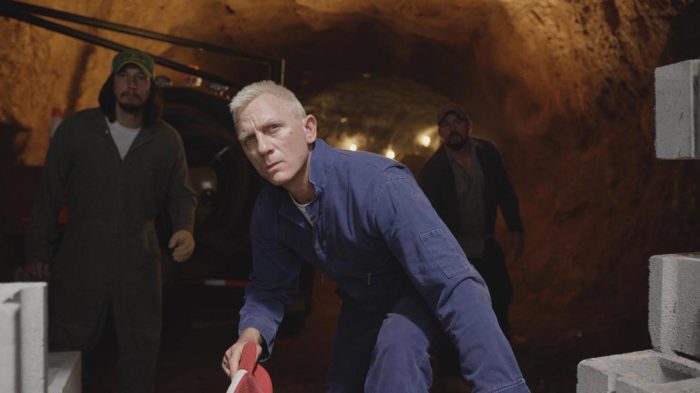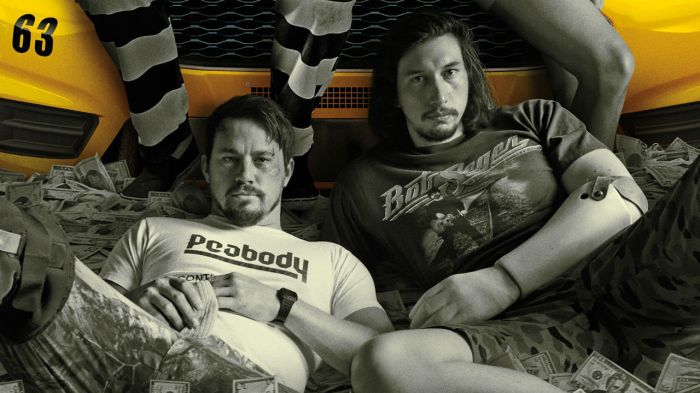Steven Soderbergh is back in the director’s chair.
After a years-long hiatus, Soderbergh is back with a new cast and a new self-funded distribution company to add another heist-driven entry to his list of works. Logan Lucky, which premiered on August 18th, is an action-comedy billed as a way to “see how the other half steals,” as the tagline suggests, starring Channing Tatum and Adam Driver in lead roles as down-on-their-luck brothers from West Virginia who plot to steal millions from Charlotte Motor Speedway during a NASCAR event.
Unsurprisingly, and given the film’s premise, a number of parallels can be drawn to the Ocean’s trilogy within Logan Lucky – some of these parallels are as overt as the so-called “Hillbilly Heist” also at times being referred to as “Ocean’s 7-11,” whereas others (elements of the heist itself, which I’ll refrain from divulging here) aren’t as easily seen by the average moviegoer. David Holmes, who crafted the distinctive drum-driven soundtracks for Ocean’s 11, 12, and 13, returns to collaborate with Soderbergh once again, developing musical themes for a similar subject matter but adapting well to the stark change in setting and overall ambiance. In a sense, Soderbergh and Co. are following an already proven formula, but are doing so in a new skin, with fresh faces and a lower budget. Simply put, while it could be seen as unoriginal, it’s undeniable that it still works.

Jimmy Logan buys all of his heist hardware from Lowe’s. Stellar product placement.
Channing Tatum, Soderbergh’s proven leading man of Magic Mike fame, plays the central role of Jimmy Logan, a former college football star turned construction worker with a nagging knee injury that gets him laid off in the film’s early action. Where Tatum finds the role’s meat is in his relationship with his daughter, a pageant-bound blonde with a rich new family but a strongly maintained bond with her father. Jimmy Logan’s connection with his daughter seemingly accounts for his motivation to plan the heist that forms most of the film’s action, and it manages to create a suitable amount of drama for the movie it’s in. Another source of drama and story depth: Jimmy’s relationship with his brother Clyde, which seems rich with a history of past brushes with the law, among other (here untold) conflicts.
In terms of comedy, Adam Driver’s character and performance without a doubt carry the most weight, which may seem surprising given the character’s background – Clyde Logan is an Iraq war veteran and bartender who wears a prosthetic arm and (surprisingly) bears the brunt of very few amputee-related jokes throughout the course of the film. Another bright spot in the cast is the performance of Daniel Craig, who portrays the incarcerated demolitions expert, aptly named Joe Bang, who is in fact sprung from a correctional facility with a serious riot problem to perform the primary heist. A spot-on Southern accent, a thick layer of superficial hillbilly charm placed atop a tattoo-addled convict’s frame, and an excellent demonstration of situational comedy and, believe it or not, chemistry (not acting chemistry, mind you – I’m talking about the chemistry that involves atoms) at the mid-heist point form the highlights of his turn in the movie. Similarly enjoyable are Joe Bang’s two brothers, Sam and Fish (yes, Fish) Bang, played by Brian Gleeson and Jack Quaid respectively, who sign on for minor roles in the heist due to what they perceive as “moral wrongdoing” on the part of the Speedway.

Daniel Craig is excellent in his supporting role as Joe Bang, here doing a very Bond-esque pose.
The low point in terms of both cast and plot has to be Seth MacFarlane, who has something like ten minutes of screen time out of the two-hour runtime but still manages to stick out like a sore thumb, mostly by delivering a truly subpar English accent as a part of his energy-drink mogul character. While I’m sure MacFarlane’s character was written to be annoying to the average audience, he (or Soderbergh) may have missed the mark by going too far. Poor accent and acting aside, his character typically serves as a distraction with no real bearing on the plot, other than to arguably drive the Logans to initially plan the heist by instigating an ill-advised barfight. He later reappears to offer a brief but uninspired apprehension scare to the audience in the film’s denouement, which is largely written off almost immediately.
I’d argue that his talents, along with those of Sebastian Stan (who has maybe 5 lines throughout the movie, with even less screen time than MacFarlane) and Katie Holmes, are misused in Logan Lucky, but this could simply be a byproduct of all of the more heavily featured acting talent that surrounds them. The misuse of talent narrative is also somewhat put to bed by the work of Hilary Swank, who has an equally small role as a lead FBI investigator, not appearing until very late in the movie but still managing to drive the narrative effectively and with solid acting to boot. While once again not going into specifics, the final scene suggests that she’ll play a larger part should a franchise and/or sequel develop.

That pile of money they’re laying in is the amount this movie should be making.
All members of the cast come together to bring to life a script that’s filled with a surprising amount of solid laughs, along with the caper-driven horseplay that all Ocean’s lovers paid to see. Logan Lucky doesn’t really attempt to do anything impressive visually, but for the most part this is because it doesn’t need to. With a smart plot, solid acting from its central characters, a number of good jokes, and the requisite amount of Southern country authenticity, this movie provides everything that it has to. All told, Logan Lucky is an excellent late-summer pick that lacks a blockbuster budget but has the star-studded cast and overall production value to be considered a hit worthy of a sequel. It’s definitely a shame that this movie hasn’t been marketed more aggressively, as it’s truly a gem that’s far more worthy of your attention than its box-office earnings would suggest.
[…] which gives the movie a dose of Southern charm reminiscent of Logan Lucky, another movie I reviewed here. Is this “redneck chic” approach to filmmaking a trend that will continue? Both of […]
LikeLike
[…] Movies Seen: 2 (Logan Lucky, Ocean’s […]
LikeLike